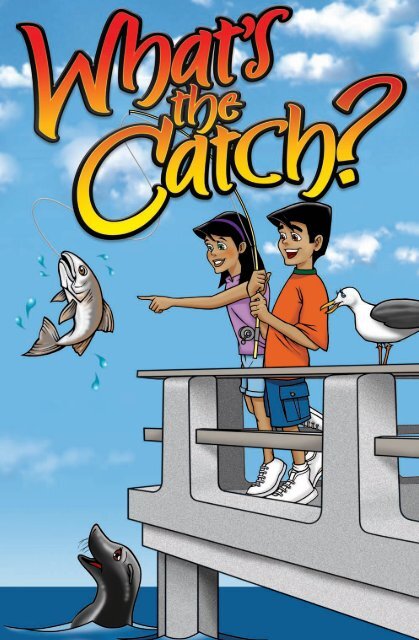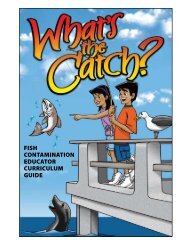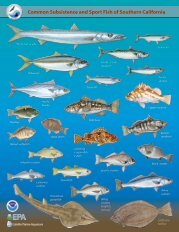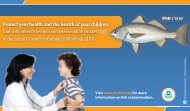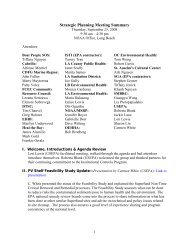MSRP and Cabrillo Aquarium Comic Book - Fish Contamination ...
MSRP and Cabrillo Aquarium Comic Book - Fish Contamination ...
MSRP and Cabrillo Aquarium Comic Book - Fish Contamination ...
You also want an ePaper? Increase the reach of your titles
YUMPU automatically turns print PDFs into web optimized ePapers that Google loves.
<strong>MSRP</strong> is a multi-agency effort to restore natural resources harmed by past releases of DDTs <strong>and</strong> PCBs in the southern<br />
California marine environment. Funded by a legal settlement with the companies <strong>and</strong> industries responsible for the chemical<br />
releases, <strong>MSRP</strong> is working on a variety of restoration projects, including projects to restore fishing opportunities in<br />
Southern California. For more information, please visit us at www.montroserestoration.gov or call (562) 980-3236.<br />
<strong>Cabrillo</strong> Marine <strong>Aquarium</strong> is an educational, recreational, <strong>and</strong> research facility<br />
dedicated to providing rich <strong>and</strong> varied opportunities for early <strong>and</strong> continuing education of<br />
the general public about the marine environment of Southern California. <strong>Cabrillo</strong> Marine<br />
<strong>Aquarium</strong> is located at 3270 Stephen White Drive in San Pedro <strong>and</strong> is a facility of the City<br />
of Los Angeles Department of Recreation <strong>and</strong> Parks. Visit our website at www.cabrilloaq.org or call (310) 548-7562.
Am<strong>and</strong>a, a western sea gull, likes to hunt for food in San Pedro,<br />
an old fishing town <strong>and</strong> seaport in Los Angeles Harbor.<br />
Let's see what's happening at <strong>Cabrillo</strong> Pier...<br />
Hmm. Plenty of people fishing. Let’s see who is there.<br />
It’s Mariza <strong>and</strong> Jose fishing<br />
with their dad!<br />
1
Hi, friends! What are you catching?<br />
Different kinds of fish.<br />
You can take a look…<br />
if you promise not to<br />
steal them!<br />
Hey! We western gulls don't steal<br />
food! We just raid a garbage can<br />
once in a while...<br />
Now let's see what you've got here...<br />
A BONITO - cool! See, you can tell from<br />
the narrow tail <strong>and</strong> long slanting stripes<br />
up the sides of the body.<br />
Wow! A MACKEREL!<br />
Look at that!<br />
2
Hey!<br />
I caught one!<br />
Uh oh.<br />
What’s wrong?<br />
That’s a WHITE CROAKER!<br />
We call it TOMCOD or sometimes<br />
KINGFISH! See it’s silvery-white with<br />
a wide tail, no obvious markings <strong>and</strong> it’s<br />
small mouth faces down.<br />
They taste good!<br />
Yes, they taste good, but the<br />
WHITE CROAKER caught around<br />
here have unhealthy chemicals called<br />
DDT <strong>and</strong> PCBs in them!<br />
Why here?<br />
I’ll tell you the story. It’s a little complicated...<br />
3
Long ago, a big factory in Los Angeles made DDT, a mix of chemicals that was widely<br />
used from the 1940s to the 1970s to kill insects. Other factories used chemicals<br />
called PCBs for things like making paper <strong>and</strong> colling electrical transformers.<br />
A lot of waste DDT <strong>and</strong> PCBs went into the Los Angeles County sewage system. But<br />
the sewage treatment plant which cleans up our household waste could not clean up<br />
the DDT <strong>and</strong> PCBs, so they went into the ocean along with the waste water.<br />
The factories also dumped their waste chemicals on their properties <strong>and</strong> when it<br />
rained, the chemicals washed into storm drains <strong>and</strong> into the Los Angeles Harbor.<br />
Scientists found that letting DDT <strong>and</strong> PCBs get into the<br />
ocean was bad for wildlife like fish <strong>and</strong> birds <strong>and</strong> for people.<br />
In 1971, the county sewage plant stopped factories from<br />
putting these chemicals into the sewer pipes, <strong>and</strong> the<br />
government made the factories clean up their dumps.<br />
4 5
The united States <strong>and</strong> many other countries have<br />
banned the use of DDT <strong>and</strong> PCBs. But now, more<br />
than 30 years later, some DDT <strong>and</strong> PCBs remain<br />
on the ocean bottom around Los Angeles, <strong>and</strong> still<br />
contaminate many of the fish we catch.<br />
Both DDT <strong>and</strong> PCBs last for many years in the environment. No<br />
one knows how to remove these chemicals from our ocean or how<br />
many years the DDT <strong>and</strong> PCBs will continue to cause problems.<br />
What do<br />
DDT <strong>and</strong> PCBs<br />
do to fish <strong>and</strong><br />
birds?<br />
Let’s see…Ah ha!<br />
There he is!<br />
Well...I know a friend who can<br />
help me explain it to you.<br />
Ahoy, Fern<strong>and</strong>o!<br />
6
Ahoy Am<strong>and</strong>a! What brings<br />
you this way?<br />
Could you could help<br />
me explain about DDT<br />
<strong>and</strong> PCBs to some<br />
friends of mine?<br />
DDT <strong>and</strong> PCBs?<br />
I’d be glad to!<br />
Mariza, Jose…<br />
...meet Fern<strong>and</strong>o!<br />
Hi kids!<br />
Hi!<br />
Cool! He's a<br />
California sea lion!<br />
Am<strong>and</strong>a said you wanted to<br />
know more about DDT <strong>and</strong> PCBs.<br />
I’ll tell you what I know...<br />
7
White Point/Royal Palms<br />
SAN PEDRO<br />
Los Angeles<br />
Harbor<br />
Waste Water<br />
Outfall Pipes<br />
Point Fermin<br />
<strong>Cabrillo</strong><br />
Pier<br />
breakwater<br />
The pipelines from the county sewage<br />
treatment plant go into the ocean here<br />
at White Point/Royal Palms in San Pedro...<br />
...<strong>and</strong> here, two miles off shore,<br />
<strong>and</strong> 200 feet underwater, the<br />
treated waste water comes out.<br />
During the 1950s<br />
<strong>and</strong> 1960s, many<br />
tons of DDT <strong>and</strong><br />
PCBs came out of<br />
these pipes in the<br />
waste water.<br />
8
These toxic chemicals<br />
spread with the ocean<br />
currents <strong>and</strong> the DDT<br />
<strong>and</strong> PCBs became buried<br />
in the s<strong>and</strong> <strong>and</strong> mud on<br />
the sea bottom from<br />
Palos Verdes <strong>and</strong> into<br />
Santa Monica Bay.<br />
The trouble with DDT <strong>and</strong> PCBs is that<br />
they last a long time in our environment<br />
Animals on the bottom, like<br />
these ice cream cone<br />
worms <strong>and</strong> shrimp, eat or<br />
soak up DDT <strong>and</strong> PCBs<br />
MMmmmmm....Such<br />
delicious mud!<br />
Bottom-feeding<br />
fish eat the<br />
bottom animals.<br />
If these fish stay in the Palos<br />
Verdes area – like the WHITE<br />
CROAKER – they become<br />
contaminated with DDT <strong>and</strong> PCBs!<br />
Slurp!<br />
••••••••••••••••••••••••••••••••••••••••••••••••••••••••<br />
Other fish <strong>and</strong> animals like me eat the<br />
contaminated fish. The DDT <strong>and</strong> PCBs<br />
stay in our bodies, so we become<br />
contaminated too!<br />
9
People started noticing that California brown<br />
pelicans were crushing their eggs as they tried<br />
to warm them in the nest.<br />
Pelicans eat only fish,<br />
Scientist discovered that<br />
DDT from fish caused<br />
them to lay eggs with<br />
weak eggshells.<br />
The eggshells were too<br />
thin, <strong>and</strong> almost all the<br />
baby pelicans died!<br />
DDT hurt other birds too. For example,<br />
bald eagles on Catalina Isl<strong>and</strong> are getting<br />
too much DDT from their food.<br />
So the eagle chicks die in their<br />
eggs before they can hatch.<br />
10
And DDT <strong>and</strong> PCBs are especially bad for<br />
human babies <strong>and</strong> children too! Mothers<br />
who are nursing a baby <strong>and</strong> women who are<br />
pregnant or may become pregnant should<br />
avoid eating contaminated fish.<br />
Growing children should also<br />
avoid eating these fish.<br />
Eating these contaminated fish can cause health problems for<br />
people who eat a lot of the fish over many years. White croaker are<br />
the most contaminated fish in the Los Angeles area.<br />
That's why you, Mariza <strong>and</strong> Jose,<br />
should not eat WHITE CROAKER<br />
caught in Palos Verdes <strong>and</strong><br />
should also be careful about other<br />
types of fish you eat.<br />
How can we tell which kinds<br />
of fish are OK to eat?<br />
We’ll show you.<br />
11
Very sleek fish like MACKEREL <strong>and</strong> BONITO<br />
are low in DDT <strong>and</strong> PCBs. They’re fast<br />
swimmers that travel widely—they don’t stay<br />
in this contaminated area.<br />
Mackerel<br />
Bonito<br />
Surf Perch<br />
You should be cautious with other fish like<br />
kelp bass, surfperches, corbina, rockfish,<br />
scorpionfish, <strong>and</strong> with sea urchins <strong>and</strong> crabs<br />
These are OK TO EAT if you eat them only<br />
once in a while from this area, like maybe<br />
once or twice a month.<br />
Kelp Bass<br />
Scorpionfish<br />
Corbina<br />
Rockfish<br />
White Croaker<br />
Crab<br />
Sea Urchin<br />
12
Bye Fern<strong>and</strong>o!<br />
Thanks!<br />
Okay kids, let’s clean these fish. Mom’s<br />
waiting for us at the picnic area.<br />
Bye kids!<br />
You’re dad is doing the right<br />
thing, he’s returning the<br />
White Croaker.<br />
This is called “catch<br />
<strong>and</strong> release”.<br />
Just to be careful<br />
he’s cleaning<br />
these fish the<br />
right way too!<br />
He’s throwing away all the<br />
insides, the fatty areas, the<br />
dark meat areas <strong>and</strong> the skin!<br />
These parts of the fish have<br />
the most DDT <strong>and</strong> PCBs.<br />
The light-colored meat on the sides<br />
of the body is the safest to eat.<br />
13
Later at the picnic area...<br />
That means that most of the FAT, the<br />
MOST CONTAMINATED part, is<br />
dripping away, leaving you with the<br />
safer parts to eat!<br />
Your mom <strong>and</strong> dad are grilling<br />
the fish! That’s great!<br />
Grilling <strong>and</strong> steaming are the<br />
best ways to cook the fish.<br />
Pan-frying, or even worse, throwing the whole<br />
fish into a soup, are NOT good, because all the<br />
toxic chemicals stay with the fish you eat.<br />
You know, fish is a<br />
great food—nutritious<br />
<strong>and</strong> usually healthy!<br />
And it tastes great!<br />
Yes it does!<br />
But in the Los Angeles area, you have to be careful<br />
where you catch the fish, <strong>and</strong> which ones you eat!<br />
14
Be careful which fish you buy<br />
from a restaurant or a market.<br />
Tell your mom <strong>and</strong> dad<br />
not to buy any WHITE<br />
CROAKER caught near<br />
Los Angeles!<br />
And remember,<br />
it's also known as<br />
KINGFISH <strong>and</strong><br />
TOMCOD!<br />
Boy, all this talk about fish has made me hungry!<br />
Me too! I saw some tasty<br />
looking fish near the pier.<br />
Remember, NO WHITE CROAKER! <strong>and</strong> be<br />
careful about the other fish you eat, too!<br />
15
Some of the most common fish along the<br />
Los Angeles coast are contaminated with<br />
DDT <strong>and</strong> PCBs. The State of California<br />
suggests you limit the amount of some of<br />
the fish you eat.<br />
Use the drawings on the next page to know<br />
what fish you catch. Compare them to<br />
consumption advisories in your area to help<br />
you decide what fish you can keep <strong>and</strong> eat.<br />
You can learn more about fish contamination <strong>and</strong><br />
consumption advisories by:<br />
• Looking for signs on fishing piers.<br />
• Talking to people h<strong>and</strong>ing out information about fish<br />
contamination. They can usually be found at your<br />
fishing pier, at health clinics, <strong>and</strong> at local fairs.<br />
• Visiting www.oehha.gov/fish.html, the website of<br />
California's Office of Environmental Health Hazard<br />
Assessment, a government group that creates<br />
the advisories.<br />
16
Pacific barracuda<br />
Pacific sardine<br />
Jacksmith<br />
Topsmelt<br />
Pacific (chub) mackeral<br />
Pacific bonito<br />
White seabass<br />
Yellowjack tail<br />
Opaleye<br />
Black perch<br />
Kelp bass,<br />
calico bass<br />
Barred surfperch<br />
Sculpin, California<br />
scorpionfish<br />
Barred s<strong>and</strong>bass<br />
Yellowfin croaker<br />
Queenfish<br />
Copper rockfish<br />
White croaker,<br />
kingfish, tomcod<br />
Spotfin croaker<br />
Black croaker<br />
California corbina<br />
Shovelnose guitarfish<br />
California halibut
The most contaminated fish are in the ocean near San Pedro <strong>and</strong><br />
Palos Verdes, <strong>and</strong> in the harbors for Los Angeles <strong>and</strong> Long Beach.<br />
DO NOT eat white croaker from these areas.<br />
Mothers be careful! DDT <strong>and</strong> PCBs could<br />
be especially bad for babies. Mothers<br />
who are nursing a baby <strong>and</strong> women who<br />
are pregnant, or may become pregnant,<br />
should avoid eating fish from areas<br />
contaminated with DDT <strong>and</strong> PCBs.<br />
Unless you know the fish<br />
you catch are not<br />
contaminated, eat only<br />
the fish fillet – the<br />
light-colored meat<br />
from the fish.<br />
DDT <strong>and</strong> PCBs are mostly in the<br />
fatty parts of the fish. Throw<br />
away the skin, belly fat, dark meat<br />
<strong>and</strong> head of the fish. These parts<br />
have the most fat.<br />
And always throw away the<br />
oil used to fry fish.


